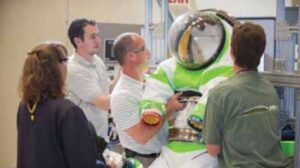The current U.S. space suit used by NASA is a dinosaur.
Designed in 1992, it was only ever intended to be used by crews aboard the Space Shuttle and the International Space Station (ISS). That may have been good enough in the days of 14 kps modems, but with eyes turning increasingly toward missions to the Moon, Mars and the asteroids, space explorers need something better. That’s why NASA is designing its first new suit in twenty years. Developed by NASA’s Advanced Exploration Systems (AES), the Z-1 prototype space suit currently undergoing vacuum testing at the Johnson Space Center is a wearable laboratory of new technology. And it’s a hatchback.
Space suits in popular culture are very simple things. If film and television are anything to go by, then space suits are as easy to use as coveralls and can be donned in a matter of seconds. Zip it up, put the helmet on and off you go. Nothing could be further from the truth. True, we’ve all seen astronauts walking out to the launch pad wearing what look like space suits, but those are actually emergency pressure suits used to protect the crew inside the craft for a short time in the event of the ship leaking air.
Real space suits of the sort used to work outside the ISS or for walking on the Moon are a very different affair. They’re more like miniature spaceships with arms and legs. These are highly complex systems that require extensive training to use and, far from getting one on in seconds, it takes more like an hour. If you regard emergency pressure suits as being the equivalent of a scuba outfit, then a space suit is a mixed-gas deep diving rig.
The suit needs to do everything that a spaceship does. It needs to protect the wearer from heat, cold and micrometeorites. It needs to supply oxygen and remove carbon dioxide and contaminants from the air. It also needs to be lightweight, compact and reasonably flexible – which isn’t easy when you recall that a spacesuit is essentially a balloon.
The “Z-1 Prototype Spacesuit and Portable Life Support System (PLSS) 2.0,” to give it its proper name, is what is called a “rear-entry space suit” made up of a combination of several hard elements mounted on a suit of fabric that’s flexible when uninflated. To get in, the astronaut uses a “suitport.” This is a combined hatch and life support pack on the back of the suit’s torso. The neat thing about the Z-1 is that the hatch allows it to latch onto a spaceship, rover or habitat.
Once docked, the suit’s hatch can open inside the craft and the astronaut can get in and out of the suit without using an airlock. This means that the wearer can get in and out much faster, less air is wasted than with an airlock and the astronaut doesn’t have to do so much “Prebreathing.” That is, inhaling pure oxygen to avoid getting the bends in the lower pressure of the suit. The Z-1 makes this less necessary because it operates at the same pressure as a spaceship. It has to or the hatch wouldn’t open because of the pressure difference.
via Gizmag – David Szondy
The Latest Streaming News: Spacesuit updated minute-by-minute
Bookmark this page and come back often
Latest NEWS
Latest VIDEO








